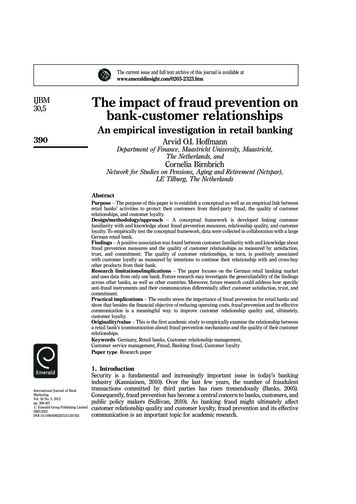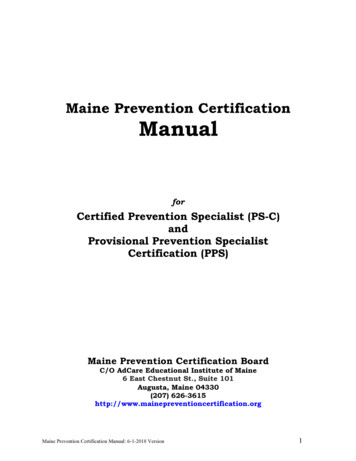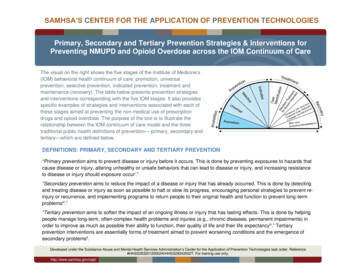
Transcription
The current issue and full text archive of this journal is available atwww.emeraldinsight.com/0265-2323.htmIJBM30,5The impact of fraud prevention onbank-customer relationshipsAn empirical investigation in retail banking390Arvid O.I. HoffmannDepartment of Finance, Maastricht University, Maastricht,The Netherlands, andCornelia BirnbrichNetwork for Studies on Pensions, Aging and Retirement (Netspar),LE Tilburg, The NetherlandsAbstractPurpose – The purpose of this paper is to establish a conceptual as well as an empirical link betweenretail banks’ activities to protect their customers from third-party fraud, the quality of customerrelationships, and customer loyalty.Design/methodology/approach – A conceptual framework is developed linking customerfamiliarity with and knowledge about fraud prevention measures, relationship quality, and customerloyalty. To empirically test the conceptual framework, data were collected in collaboration with a largeGerman retail bank.Findings – A positive association was found between customer familiarity with and knowledge aboutfraud prevention measures and the quality of customer relationships as measured by satisfaction,trust, and commitment. The quality of customer relationships, in turn, is positively associatedwith customer loyalty as measured by intentions to continue their relationship with and cross-buyother products from their bank.Research limitations/implications – The paper focuses on the German retail banking marketand uses data from only one bank. Future research may investigate the generalizability of the findingsacross other banks, as well as other countries. Moreover, future research could address how specificanti-fraud instruments and their communication differentially affect customer satisfaction, trust, andcommitment.Practical implications – The results stress the importance of fraud prevention for retail banks andshow that besides the financial objective of reducing operating costs, fraud prevention and its effectivecommunication is a meaningful way to improve customer relationship quality and, ultimately,customer loyalty.Originality/value – This is the first academic study to empirically examine the relationship betweena retail bank’s (communication about) fraud prevention mechanisms and the quality of their customerrelationships.Keywords Germany, Retail banks, Customer relationship management,Customer service management, Fraud, Banking fraud, Customer loyaltyPaper type Research paperInternational Journal of BankMarketingVol. 30 No. 5, 2012pp. 390-407r Emerald Group Publishing Limited0265-2323DOI 10.1108/026523212112474351. IntroductionSecurity is a fundamental and increasingly important issue in today’s bankingindustry (Kanniainen, 2010). Over the last few years, the number of fraudulenttransactions committed by third parties has risen tremendously (Banks, 2005).Consequently, fraud prevention has become a central concern to banks, customers, andpublic policy makers (Sullivan, 2010). As banking fraud might ultimately affectcustomer relationship quality and customer loyalty, fraud prevention and its effectivecommunication is an important topic for academic research.
Banking fraud hurts both banks and their customers. Banks incur substantialoperating costs by refunding customers’ monetary losses (Gates and Jacob, 2009), whilebank customers experience considerable time and emotional losses. They have todetect the fraudulent transactions, communicate them to their bank, initiate theblocking and re-issuance or re-opening of a card or account, and dispute thereimbursement of their monetary losses (Douglass, 2009; Malphrus, 2009). Becominga fraud victim may also impact customers’ perception of feeling secure and protected attheir bank. Accordingly, fraud may damage the bank-customer relationship because ofshattered trust and confidence (Krummeck, 2000), as well as increased dissatisfactionbecause of a perceived service failure (Varela-Neira et al., 2010). This, in turn, maynegatively affect customer loyalty and stimulate switching behavior (Rauyruen andMiller, 2007; Gruber, 2011), thereby hurting the banks’ reputation and impeding theattraction of new customers (Buchanan, 2010).Fraud prevention may thus entail chances for banks to enhance the relationships withtheir customers. It gives banks the opportunity to (re-)assure customer trust in theirservices (Guardian Analytics, 2011). Indeed, the associated feeling of security may be aneffective means to retain existing customers and attract new ones (Behram, 2005).However, in order to translate fraud prevention into higher-quality relationships,communication is key. Effective communication allows a bank to evoke a sharedunderstanding of values between itself and its customers (Asif and Sargeant, 2000).Banks should therefore demonstrate their knowledge and competence regarding fraudprevention by communicating anti-fraud measures effectively, thereby creating a feelingof safety among customers (Rauyruen and Miller, 2007). This feeling of safety likelyimproves customer relationship quality and customer loyalty, which are key successfactors in the highly competitive retail banking industry (Alexander and Colgate, 2000).The aim of this study is to empirically assess the impact of customer familiarity withand knowledge about fraud prevention measures on the current quality as well as futurepotential of bank-customer relationships. In so doing, we make several contributionsto the bank marketing literature. First, we develop a comprehensive framework of fraudmanagement in retail banking by integrating key concepts from the relationshipmarketing, customer loyalty, as well as fraud prevention literature. Second, byempirically testing this conceptual framework using an extensive set of survey data, weare first to show how fraud prevention measures and their effective communication arecapable to improve customer relationship quality as measured by customer satisfaction,trust, and commitment. Moreover, we show how higher customer relationship qualitysubsequently translates into customer loyalty as measured by their tendency to continuethe current relationship with a bank and to extend and enrich it through cross-buyingfrom that bank. Third, we identify how both situational factors (e.g. a customer’s priorfraud experiences) as well as socio-demographic factors (e.g. a customer’s age, gender,income, and education) moderate the prior relationships.The remainder of this study is organized as follows. Section 2 reviews relevantliterature. Section 3 introduces the conceptual framework and hypotheses. Section 4presents the research design. Section 5 empirically tests the conceptual framework.Section 6 concludes.2. Literature background2.1 Fraud management in retail bankingRetail banking fraud entails any attempt of criminals to “achieve financial gain at theexpense of legitimate customers or financial institutions through any [y] transactionBank-customerrelationships391
IJBM30,5392channel, such as credit cards, debit cards, ATMs, online banking, or checks” (Sudjiantoet al., 2010, p. 5). Recent literature categorizes fraud by the person conducting it anddifferentiates between first-party and third-party fraud. In first-party fraud, alegitimate customer betrays the bank, whereas in third-party fraud, the customerbecomes a victim of criminals who steal identities, use lost or stolen cards, counterfeitcards, or gain unauthorized access to customer accounts by other means (Gates andJacob, 2009; Greene, 2009). This study focusses on third-party fraud.Third-party fraud can be subdivided into different classes. Most common is adifferentiation between payments fraud and identity theft. Payments fraud refers to“any activity that uses information from any type of payments transaction forunlawful gain” (Gates and Jacob, 2009, p. 7). It occurs when fraudsters gain access tocustomer accounts and use these accounts for their own financial benefit (Sullivan,2010; Malphrus, 2009). Identity theft may also comprise fraudsters illicitly gainingaccess to customer accounts (Hartmann-Wendels et al., 2009), but usually refers toopening new accounts in the customer’s name (Malphrus, 2009). This study focusseson payments fraud in general and on card fraud in particular, since it is of risingimportance globally (Worthington, 2009).2.2 The nature of and trends in retail banking fraudNowadays, customers rely heavily on the web for their banking business, leading toan increase in the number of online transactions (Berney, 2008). Fraudsters react tothese changes as the internet provides them with more opportunities to attackcustomers (Gates and Jacob, 2009). On the web, customers are not physically presentto authenticate transactions, which facilitates fraud (Malphrus, 2009; Gates and Jacob,2009). Orad (2010) even claims that the internet allows criminals to organize as anetwork, supporting each other in their attacks.Fraudsters are particularly interested in accessing customers’ online bankaccounts. A common practice to steal access data are “phishing,” where an e-mailfrom an allegedly credible source is sent to bank customers requesting sensitiveinformation such as their username or password. During recent years, phishing hasbecome a significant threat to online security (Bergholz et al., 2010). Since (credit) cardshave become a major payment instrument for web-based transactions, they haveattracted great attention of fraudsters (Malphrus, 2009). Despite an inability to provideexact numbers on card fraud because of differences in banks’ fraud tracing anda lack of customer reporting, worldwide card fraud likely exceeded 10 billion in 2009(ACI Payment Systems, 2009). In general, fraud, either online or offline, hurts retailbanks’ operating performance, and increases their costs (Gates and Jacob, 2009).According to Greene (2009), the true economic costs are about 150 percent of the actualfraud loss.3. Conceptual framework and hypotheses3.1 A customer perspective on retail banking fraudBecoming a fraud victim affects customers negatively not only in terms of monetarylosses, which are typically refunded by banks, but also in terms of the efforts theyhave to make to restore the original situation (Malphrus, 2009; Douglass, 2009).Furthermore, confidence and trust into the bank may be shaken by fraud occurrences.Customers might have the impression that the “bank is not a safe place and incapableof protecting its clients’ assets” (Krummeck, 2000, p. 268). They lose trust, becomedissatisfied (Varela-Neira et al., 2010), and may switch to a different financial services
provider (Gruber, 2011; Bodey and Grace, 2006). Accumulated fraud incidents canhave a profound negative impact on a bank’s reputation and hurt it in several ways(Krummeck, 2000; Malphrus, 2009).Proactive fraud management is an opportunity for banks to (re-)assure customertrust (Guardian Analytics, 2011) and may be a means to retain existing and attract newcustomers (Behram, 2005). Bank customers are deeply concerned about fraud andstudies have shown that many would be willing to pay additional fees for a properprotection of their assets (Detica, 2010). Effective communication allows for a sharedunderstanding of values and beliefs between a company and its customers (Asif andSargeant, 2000). Communicating anti-fraud policies properly is therefore a cornerstonein fraud prevention (Krummeck, 2000) and may allow banks to materialize on thetopic’s importance to customers. Liu and Wu (2007) find that service attributes, suchas fraud prevention, can positively affect relationship continuation and cross-buying.By demonstrating their fraud prevention knowledge and know-how, banks can create afeeling of safety (Rauyruen and Miller, 2007), thereby enhancing relationship quality,which may ultimately improve customer loyalty (Morgan and Hunt, 1994).This study develops an innovative conceptual framework that integrates thesefindings and suggestions from previous research. In the framework, a bank’scommunication regarding fraud prevention is positively linked to the quality ofthe relationship with its customers as measured by customer satisfaction, trust, andcommitment. Relationship quality, in turn, is expected to enhance customer loyaltyas measured by their intentions to continue the relationship with their bank and tocross-buy other products or services from this same bank. Figure 1 provides agraphical summary of the conceptual framework that this study examines.Bank-customerrelationships3933.2 Customer relationshipsEffective anti-fraud management and its communication toward customers potentiallyenhances relationship quality and, ultimately, loyalty. While there are many differentforms of relationships, differentiated by type or participants (Morgan and Hunt, 1994),this study deals with the relationships of banks with their retail customers. From thebank’s perspective, customer relationships can be built at the company or the employeelevel (Rauyruen and Miller, 2007; Liu et al., 2011). Since fraud management is acorporation-wide approach (Malphrus, 2009), this study focusses on company-levelRelationship qualitySociodemographicsSatisfactionwith bank andservicesFraud preventionCustomer familiaritywith and knowledgeof bank’s fraudpreventionPersonalfraudaffectionCustomer loyaltyCustomerintention tocontinuerelationshipTrust in bank andservicesCustomerintention forcross-buyingCommitmentto bankFigure 1.Conceptual framework
IJBM30,5394relationships. Prior work identifies relationship quality and customer loyalty as crucialconstructs in such customer relationships.3.2.1 Relationship quality. Relationship quality refers to the strength of arelationship (Dimitriadis and Papista, 2010), and is generally composed of satisfaction,trust, and commitment (Morgan and Hunt, 1994; Dimitriadis and Papista, 2010;Liu et al., 2011). All three constructs are key variables in establishing long-termrelationships (Gutierrez, 2005) and are typically claimed to be positively related tocustomer loyalty (Liu et al., 2011; Garbarino and Johnson, 1999; Dimitriadis andPapista, 2010; Morgan and Hunt, 1994; Randall et al., 2011).Satisfaction. Satisfaction refers to the post-purchase evaluation of products or servicesby a customer (Liu et al., 2011; Randall et al., 2011). Customers use past experience,expectations, predictions, goals, and desires (Liu et al., 2011) to assess the quality of all pastinteractions with the respective company, in this case their bank. Satisfaction is more thanfulfilling prior expectations: only exceeding expectations fosters customer intention to staywith their current service provider (Aldas-Manzano et al., 2011; Dimitriadis, 2010).As bank customers attach great importance to fraud prevention and are willingto pay for these services (Detica, 2010), we hypothesize that a solid and regularcommunication about fraud and the measures that are taken to prevent it, will lead toincreased levels of satisfaction:H1. Customers’ fraud prevention knowledgeability, as triggered by bankcommunication, is positively associated with their satisfaction with the bank.Trust. Trust is a critical success factor in firm-customer relationships (Suárez Álvarezet al., 2011). In the context of this study, it comprises the perceived credibility andbenevolence of the bank toward the customer (Doney and Cannon, 1997; Liu et al., 2011;Rauyruen and Miller, 2007). Customer trust is expressed as confidence in the qualityand reliability of the firm’s products and services (Liu et al., 2011; Garbarino andJohnson, 1999). It mediates customer behavior before and after a purchase decision(Liu et al., 2011), and is the critical basis for a successful relationship (Rauyruen andMiller, 2007). Morgan and Hunt (1994) find that trust is largely dependent oncommunication and shared values. The timely passing on of meaningful information“fosters trust by [y] aligning perceptions and expectations” (Morgan and Hunt, 1994,p. 25). Liu and Wu (2007) show that the perceived level of competence determines theextent to which customers trust their bank. In the context at hand, this suggests thatbanks can enhance customers’ trust in the bank and its competences to fight fraudby effectively communicating about their anti-fraud measures (Krummeck, 2000):H2. Customers’ fraud prevention knowledgeability, as triggered by bankcommunication, is positively associated with their trust in the bank.Commitment. Commitment refers to the effort that relationship partners are willing toput into the relationship because of their evaluation of its importance (Morgan andHunt, 1994). It expresses an “emotional bond and sense of belonging” which thecustomer feels toward the firm (Lewis and Soureli, 2006, p. 18). Commitment evolveswhen customers consider the “ongoing relationship [y] sufficiently important towarrant maximum efforts at maintaining it” (Randall et al., 2011, p. 7). Morgan andHunt (1994) find that commitment is largely influenced by relationship benefits andshared values. Fraud prevention represents a common interest of a bank and its
customers and thus forms a shared value. Commitment is therefore hypothesized to beenhanced through effective fraud management communication:Bank-customerrelationshipsH3. Customers’ fraud prevention knowledgeability, as triggered by bankcommunication, is positively associated with their commitment to the bank.3.2.2 Customer loyalty. Customer loyalty is a typical outcome of relationship quality(Rauyruen and Miller, 2007). It is often defined as the commitment to re-buy aparticular product or service (Liu et al., 2011) “despite situational influences andmarketing efforts that might have the potential to cause switching behaviour” (AldasManzano et al., 2011, p. 1167). In a banking context, loyalty is typically high asrelationships are often long-term oriented (Liu et al., 2011; Morgan and Hunt, 1994) andswitching costs are substantial (Kumar et al., 2008).Loyalty consists of both attitudinal and behavioral loyalty (Rauyruen and Miller,2007; Lewis and Soureli, 2006; Aldas-Manzano et al., 2011; Baumann et al., 2011). Whilebehavioral loyalty is observable through actual repurchases, attitudinal loyalty isreflected by customer preferences or intentions (Aldas-Manzano et al., 2011; Lewis andSoureli, 2006). This study focusses on loyalty as an attitudinal concept. Loyaltycomprises both the continuation of a relationship as well as the enrichment thereofthrough cross-buying (e.g. Liu and Wu, 2007).Relationship continuation. Relationship continuation or retention describes aconcept in which the company-customer relationship is prolonged through a customermaking a repetitive decision for a product, service, or provider (Liu and Wu, 2007). Liuet al. (2011) stress that primarily in saturated markets like retail banking, it is crucial tofocus on retaining customers instead of recruiting new ones. Customer retention isespecially important as remote contact between the bank and the customer, as throughthe internet, is becoming more common (Lewis and Soureli, 2006; Lee, 2002). Generally,satisfaction with current products and services is regarded as a major antecedent ofcustomer loyalty (Liu et al., 2011; Rauyruen and Miller, 2007):H4. Customers’ satisfaction with their bank is positively associated with theirintentions to continue the relationship with the respective bank.Next to satisfaction, trust is an acknowledged predecessor of loyalty, as it allowsrelationship partners to focus on the long-term benefits of their exchange (Doney andCannon, 1997). Trust is often found to be significantly related to customers’ willingnessto continue the relationship (Rauyruen and Miller, 2007; Dimitriadis and Papista, 2010;Dimitriadis, 2010):H5. Customers’ trust in their bank is positively associated with their intentions tocontinue the relationship with the respective bank.Alongside trust, commitment is considered a differentiating element between successfuland unsuccessful long-term relationships (Garbarino and Johnson, 1999). It is a key elementto loyalty (Rauyruen and Miller, 2007; Beerli et al., 2004), as committed customers aregenerally more receptive to company communications and promotions (Parahoo, 2012):H6. Customers’ commitment to their bank is positively associated with theirintentions to continue the relationship with the respective bank.395
IJBM30,5396Cross-buying. Cross-buying comprises an enrichment and advancement of customerrelationships through a customer deciding to purchase or use additional productsor services from the same provider (Kumar et al., 2008; Liu and Wu, 2007). Despitethe previously stressed importance of customer retention, Verhoef et al. (2001) notethat mere retention is not sufficient for success: managers have to find ways to selladditional products to existing customers. Kumar et al. (2008) find that this a commonpractice in the saturated financial services industry and retail banking. It is importantto consider, however, that from a customer perspective the decision to purchaseadditional products involves higher risk and uncertainty than sticking with knownproducts and services. Satisfaction with previously used products and services and thebank as such is therefore an important predecessor of customers’ cross-buyingintentions (Liu and Wu, 2007; Ngobo, 2004):H7. Customers’ satisfaction with their bank is positively associated with their crossbuying intentions.Trust that developed during the existing relationship of a customer with its bank helpsreducing uncertainty about what to expect from new products and services offered bythe same bank. As a result, customer trust facilitates cross-buying intentions (Liu andWu, 2007):H8. Customers’ trust in their bank is positively associated with their cross-buyingintentions.Finally, commitment is expected to be a positive trigger of cross-buying intentions.Committed customers appreciate the relationship with their bank and are willing toextend that relationship by also purchasing other products and services from thatbank. Indeed, Parahoo (2012) finds that committed customers are more attentive topromotions/offerings:H9. Customers’ commitment to their bank is positively associated with their crossbuying intentions.3.3 Moderating factorsWe expect the proposed effects to be stronger for customers who have been personallyaffected by fraud before. As outlined by Malphrus (2009) and Douglass (2009),customers have to take great efforts in order to restore the original situation and evenmore severely, their feeling of the bank as a safe place is affected negatively(Krummeck, 2000). They may therefore pay more attention to the measures that theirbank employs against third-party fraud:H10. The effect of customer fraud prevention knowledgeability on customerrelationship quality is stronger for customers who have been personallyaffected by banking fraud.Next to the stated hypotheses, we include various socio-demographics such as gender,age, education, and income in the following analyses in order to examine whether theyfunction as moderators of the relationship between fraud prevention and relationshipquality.
4. Research designTo test the hypotheses of the conceptual framework, an online survey was developedand conducted amongst a sample of customers of a large German retail bank. Next,we discuss the data collection process, sample, questionnaire design, and measurementinstruments in detail.Bank-customerrelationships4.1 Data collection processBefore the final data collection, a pre-test with 71 bank customers was administered toensure respondents understood all survey items and to check scale validity andreliability. Following this pre-test, some survey items were dropped or modified. Thefinal questionnaire was distributed to 18,790 customers of the cooperating bank, whichwere randomly selected on the precondition that half of them had been affected byfraud during their relationship with the respective bank. Selected customers received amessage in their online banking environment, which contained an invitation toparticipate and a link to the questionnaire.3974.2 Sample descriptionAfter a collection period of two weeks, we obtained a response of 1,491 completesurveys. Of the respondents, 75.4 percent are male and the average (median) age is 48(45) years. Respondents hold contracts with on average 2.52 banks (including theirhouse bank). Relationship length ranges from 0 to 55 years with a mean (median) of15.91 (ten) years. Of the respondents, 74.9 percent earn a net monthly income of morethan 1,800 euros, 15.2 percent have a higher education entrance qualification, and 58.9percent indicate they are university graduates.To check for non-response bias, we compare early and late respondents (Armstrongand Overton, 1977). We found a slight shift toward female respondents, highereducation levels, and higher income levels in late responses. However, as the majorityof respondents is highly educated and earns a relatively high income, sample selectionbias is no concern in this study.4.3 Questionnaire designThe questionnaire is divided into five sections. It starts with a section testing customerknowledge of their bank’s anti-fraud measures and then addresses their perceptionsof these measures. Sections on relationship quality and loyalty follow before thequestionnaire ends with a section on more sensitive topics like personal fraud affectionand socio-demographics.4.4 Measurement scalesWe use established scales to measure all constructs. The scales are only modified interms of wording to fit the context or changed to five-point scales for a uniformappearance.To measure customers’ familiarity with their bank’s fraud management measures,we used a three-item bipolar adjective scale, which has been adapted from Oliver andBearden (1985). The scale addresses both how well customers feel informed by theirbank and how knowledgeable they consider themselves about the topic of fraudprevention in general.Regarding relationship quality, the following measures were used. Customersatisfaction with their bank and the provided services was measured with a four-itemscale from Aldas-Manzano et al. (2011). Trust was measured with a five-item scale from
IJBM30,5398Liu and Wu (2007). Customer commitment was gauged by the four-item scale ofGarbarino and Johnson (1999).Regarding customer loyalty, we used the scales for relationship continuationand cross-buying intention from Ngobo (2004). Both scales consist of four items. Thecross-buying scale describes a scenario in which a bank customer’s house bank offersthe customer a service which he or she currently obtains from another bank, at thesame terms and conditions. Four items measure the likelihood of the customer to ratherhold this service at the house bank. Two items were phrased negatively and re-codedfor the following analyses.Finally, the questionnaire contained several questions on respondents’socio-demographics. Respondents were asked to indicate their gender, birth year,income and education category, and the number of years that they have been acustomer of their house bank.4.5 Scale validity and reliabilityAll previously introduced constructs are reflective, since the manifest items arehighly correlated and the meaning of the constructs would not change if an individualitem was removed ( Jarvis et al., 2003). The constructs’ internal consistency is measuredthrough Cronbach’s a (Nunnally, 1978) as well as a measure of composite reliability,which Chin (1998a, b) claims to be more reliable as it is not affected by the number ofindicators used in the construct. All scales exceed the recommended thresholdcriterion of 0.70 for both measures (Nunnally, 1978). Convergent validity is testedby examining the factor loadings and the average variance extracted (AVE). All itemsload significantly (40.70) on their posited underlying constructs (Johnson et al., 2006).Also, all AVE scores are 40.50, so convergent validity is established (Fornell andLarcker, 1981). Discriminant analysis is checked using the Fornell and Larcker (1981)criterion. For all constructs, the square root of AVE exceeds the construct correlationswith all other constructs, indicating the measures’ discriminant validity. See Table I fordetails.5. Data analysis and resultsWe use structural equation modeling (SEM) to test the conceptual model. In particular,we employ a partial least squares (PLS) approach with a 2,000 subsamplesbootstrapping procedure using the SmartPLS software (Ringle et al., 2005). As theconceptual model is relatively complex, a PLS approach such as used in SmartPLS istypically more appropriate than using a covariance-based SEM technique such asemployed in, for example, AMOS or LISREL (Fornell and Bookstein, 1982).5.1 Main results5.1.1 Model assessment. The PLS approach such as used in SmartPLS does not providea traditional assessment of overall model fit (Chin, 1998b). Therefore, to evaluatethe model, we calculate the corrected R2s of all constructs (Ringle et al., 2005) as well asemploy a recently proposed diagnostic tool, the goodness of fit (GoF) index (seeTenenhaus et al., 2005).The corrected R2s refer to the explanatory power of the predictor variable(s) onthe respective construct and are reported in Figure 2. Customer familiarity with andknowledge about the bank’s fraud prevention measures explains 9.14 percent ofcustomer commitment, 12.34 percent of customer trust and 13.92 percent of customersatisfaction. Familiarity with and knowledge about the bank’s fraud prevention
Aldas-Manzanoet al. (2011)SatisfactionItem 1Item 2Item 3ContinuationItem 4TrustItem 1Item 2Item 3Item 4Item 5CommitmentItem 1Item 2Item 3Item 3Item 2Ngobo (2004)Garbarino andJohnson (1999)Liu and Wu (2007)Oliver and Bearden(1985)Fraud familiarityItem 1AuthorsConstructhas high integritykeeps the promises it makes to mecan be trusted at all timesis trustworthyis genuinely concerned with my needsI am proud to be a customer of m
Consequently,fraud prevention hasbecome a central concern to banks, customers,and public policy makers (Sullivan, 2010). As banking fraud might ultimately affect customer relationship quality and customer loyalty, fraud prevention and its effective communication is an important topic for academic research.










